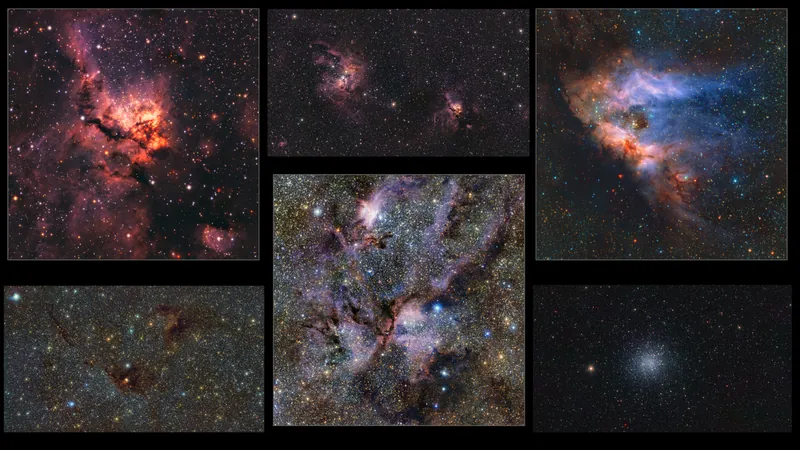
A Groundbreaking Milky Way Map Reveals 1.5 Billion Celestial Objects: The Galaxy Will Never Look the Same Again!
2024-09-27
Introduction
In a stunning astronomical achievement, researchers have unveiled the most intricate infrared map of the Milky Way, showcasing an astonishing 1.5 billion celestial bodies hidden within our galaxy. This comprehensive mapping effort was realized through the relentless work of the Visible and Infrared Survey Telescope for Astronomy (VISTA) located at the renowned Paranal Observatory in Chile. The data collection spanned over 13 years, from 2010 to 2023, as part of the ambitious VISTA Variables in the Vía Láctea (VVV) survey and its extended initiative, VVV Extended Survey (VVVX).
The newly crafted map comprises 200,000 images that collectively represent an expanse of sky equivalent to a staggering 8,600 full moons visible from Earth—tenfold the number of objects cataloged in a similar mapping effort by the same scientists back in 2012. Project leader Dante Minniti, an astrophysicist at Universidad Andrés Bello, declared, “We made so many discoveries we have changed the view of our galaxy forever.”
Mapping Breakthroughs
Utilizing VISTA's advanced infrared camera, VIRCAM, researchers successfully penetrated the dense clouds of dust and gas that typically obstruct our view of the Milky Way's inner workings. This capability enabled them to reveal previously hidden regions and paint a detailed portrait of our galactic environment.
What Wonders Await in the VISTA Milky Way Map?
The VISTA map uncovers a plethora of cosmic features, including numerous stellar nurseries teeming with nascent stars enclosed within their primordial envelopes of gas and dust. Among the highlights is the extraordinary NGC 6357, commonly referred to as the "Lobster Nebula," which lies approximately 5,900 light-years away in the constellation Scorpius.
Another incredible star-forming region identified is Messier 17, or the "Omega Nebula." Located about 6,000 light-years from Earth within Sagittarius, this vast cloud of transformative star-generation spans roughly 15 light-years yet is intertwined with a larger molecular structure approximately 40 light-years across.
Joining these vibrant stellar neighborhoods are the striking dual nebulas of NGC 3603, positioned around 20,000 light-years away, and NGC 3576—often dubbed the "Statue of Liberty Nebula"—situated just 9,000 light-years from our planet. Notably, NGC 3603 resides on one of the major spiral arms of the Milky Way and is recognized as one of the most massive young star clusters in our vicinity.
In stark contrast, the survey also captured images of ancient stars dispersed across congregations known as “globular clusters.” There are approximately 150 of these dense groupings in the Milky Way, believed to have originated from similarly collapsing clouds of cosmic material. A prime example is Messier 22 (NGC 6656), located around 10,000 light-years away, harboring stars that date back to the universe's formative years. Remarkably, Messier 22 is not just a relic of the cosmos; it also hosts at least two stellar-mass black holes and six rogue planets adrift in space. Additionally, it is one of only four globular clusters known to contain a planetary nebula, which are remnants of enormous stars that have exploded in spectacular supernovae.
Over the span of 420 nights, VISTA continuously monitored the same section of the sky. This meticulous observation allowed scientists to accurately chart the positions of identified objects and trace their motion and brightness fluctuations over time. The outcome is an unprecedented three-dimensional map of the Milky Way that cuts through the cosmic dust that has long hindered our understanding of our own galaxy.
Conclusion
As team leader Roberto Saito, an astrophysicist from the Universidade Federal de Santa Catarina in Brazil, remarked, “The project was a monumental effort, made possible because a great team surrounded us.” This historic mapping endeavor not only reshapes our comprehension of the Milky Way but also paves the way for future astronomical studies that may unlock the universe's deepest secrets. Whether you're a seasoned astrophysicist or a curious stargazer, this groundbreaking research invites everyone to gaze upon the wonders of our galaxy with newfound appreciation!





 Brasil (PT)
Brasil (PT)
 Canada (EN)
Canada (EN)
 Chile (ES)
Chile (ES)
 España (ES)
España (ES)
 France (FR)
France (FR)
 Hong Kong (EN)
Hong Kong (EN)
 Italia (IT)
Italia (IT)
 日本 (JA)
日本 (JA)
 Magyarország (HU)
Magyarország (HU)
 Norge (NO)
Norge (NO)
 Polska (PL)
Polska (PL)
 Schweiz (DE)
Schweiz (DE)
 Singapore (EN)
Singapore (EN)
 Sverige (SV)
Sverige (SV)
 Suomi (FI)
Suomi (FI)
 Türkiye (TR)
Türkiye (TR)